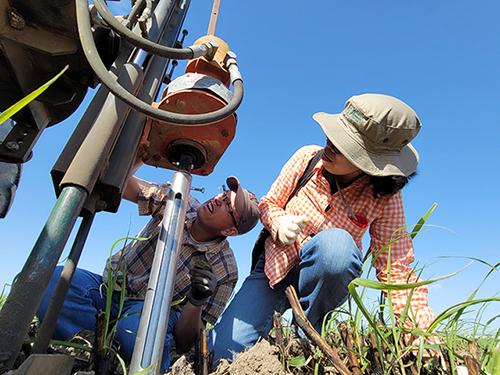
Scientists Learn to Better Feed Biorefineries
Research team seeks to maximize the supply of non-food biofuel feedstocks
The backbone of biofuel production is having the biological material to refine. Since the U.S. Department of Energy’s Billion Ton Report states that the United States could annually produce at least one billion tons of biomass without adversely affecting the environment, that doesn’t sound like too much of a problem.
However, the devil is often found in the details; finding the right plants is harder than just sowing some seeds in a field.
“For bioenergy to become a reality in the United States, it must be economically and environmentally sustainable without affecting the food supply chain,” said Anna Hale, plant geneticist with the Agricultural Research Service’s (ARS) Sugarcane Research Unit (SRU) in Houma, LA.
According to Hale, the road to a sustainable biomass industry is long and has many bumps, including the seasonal nature of these crops, the expense of transporting them, growing conditions, and adequate storage.
Hale is part of a research team that includes ARS members from the SRU in Houma and the Crop Genetics and Breeding Research Unit in Tifton, GA, along with university collaborators. Their goal is to determine the economic viability and environmental sustainability of energy cane and biomass sorghum in the southeastern United States.
Like sugarcane, energy cane is a member of the Saccharum genus, with the end use determining the crop designation. Energy cane varieties generally contain higher fiber than sugarcane, but sugar levels can vary.
The team came together to optimize yield, Hale explained. Their research includes finding the best times to grow and harvest, based on local environments; determining how storage methods and length of storage may affect biomass yield and quality; and exploring how “energy grasses,” like energy cane and sorghum, affect the environment in terms of greenhouse gas emissions, nutrient run-off, water quality, and soil erosion.
 ARS plant physiologist Patrick Ellsworth and post-doc researcher Himaya Mula-Michel work with a soil sampler while conducting research on energy cane in Houma, LA. (Photo by Anna Hale)
ARS plant physiologist Patrick Ellsworth and post-doc researcher Himaya Mula-Michel work with a soil sampler while conducting research on energy cane in Houma, LA. (Photo by Anna Hale)
Environmental factors in the Southeast that researchers must contend with include many soil types (sandy, clay, loam, etc.), temperatures, and the availability of water.
“Essentially, we are looking at a common set of varieties grown in multiple locations,” Hale said. “While one variety may thrive in the more humid environment of Houma, it may not fare well in dry conditions, such as Weslaco, TX, or cold conditions, like those encountered in Starkville, MS. Each environment is unique and, like other organisms, individuals may not perform equally under different conditions.”
Since one of the goals of this research is to reduce environmental impacts, the team is also looking at production inputs, such as fertilizer and how they can minizine the carbon footprint and greenhouse gas emissions. To do that, they’re studying production practices, harvest schedules, and placing processing facilities near the fields themselves.
“Profitable production will depend on minimizing input costs, as biomass crops have narrow profit margins,” Hale explained. “Fertilizer can increase yields, but we must pay attention to the environmental impact of crop chemicals and the effect of production on the environment. Green energy becomes less ‘green’ when biomass must be harvested by tractors and transported by trucks that use petroleum-based fuel.”
Ultimately, the team will assemble the pieces of a puzzle that results in maximum yields, minimum environmental impacts, and a steady supply of biomass for energy production, Hale said. “The more data we collect, the better the models for maximized efficiency become.
“Knowledge is power.” – by Scott Elliott, ARS Office of Communications
ARS has four National Utilization Centers in Wyndmoor, PA; Peoria, IL; New Orleans, LA; and Albany, CA. These centers evaluate the conversions of agriculture feedstocks and collaborate with the USDA Regional Biomass Research Centers to ensure dependable agricultural feedstock supplies.
Also in our biofuels series:
